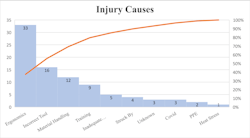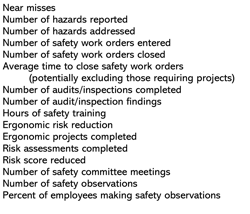Leading indicators are nothing new to occupational safety. These are metrics that indicate safety performance prior to an incident occurring. Given that occupational injuries resulted in an estimated cost of $171 billion in 2019, there is great potential benefit in proactively addressing hazards to prevent injuries CITATION Nat22 \l 1033 (National Safety Council, 2022).
However, it is not enough to select a few leading indicators and then expect safety performance to improve. To be effective, one must determine which leading indicators to use in each situation, track them accurately and evaluate the results. If any of these steps are not performed fully, then the benefits will be lacking. There will also likely be frustration and wasted effort.
Start with the End in Mind
With our busy schedules and bias toward action, it is tempting to move through the selection process quickly. Resist that temptation. Instead, make sure you have a clear picture of what you are trying to accomplish.
Envision your safety program in the future. How does it look? Think about the perceptions, decisions, stories and behaviors that need to be in place for your future vision CITATION Mat13 \l 1033 (Mathis & Galloway, 2013).
From there, try to identify the observable signs of a strong safety culture. Is the workplace clean and orderly? Are employees identifying and reporting hazards on their own? What else could you observe? Keep these things in mind as you move forward, identifying actionable areas that will, in turn, determine your leading indicators.
Also, look at your injury data to see what trends are present. There are many ways to do this depending on what you are using and your specific situation. If this is not already in place, a Pareto chart, or bar chart, is good for breaking this down (Figure 1). It helps to visualize the data and target those causes that result in the largest number of incidents.
Depending on the categories used, there will typically be three to four causes that make up around 80% of the items listed. Take some time to reflect when setting this up. The incident data and categories used as the input will need to make sense for your organization.
When it comes to leading indicators, there is no set prescription since every organization has its own personality, challenges, culture, history, etc. However, all these things need to be taken into consideration.
Creating a safety vision to guide where you want to go—along with a review of available incident data—allows you to determine what areas need to be improved most. It is also important to not get bogged down here because of the complexities involved. Provide a good, thoughtful analysis to select the results you would like to measure and then move on the next step. Remember, you are after progress, not perfection.
Select Leading Indicators
Once you have crafted a solid safety vision and reviewed incident data, it is time to select the leading indicators that will move you toward that vision. Think about what you can observe and measure to make that vision a reality. Often, near miss reporting will be an important part of any proactive safety vision.
However, there are other things that are also important. The number of hazards reported (without being a near miss) are another proactive metric. Results from a regular employee perception survey can help gauge the health of the safety culture. Some possible leading indicators to consider are listed in Table 1.
As you can see, there are many potential leading indicators. This is why it is important that you take the time to determine your specific needs and what you need to accomplish. What works well for one organization or plant is not necessarily the right fit for another.
So, what are your intended results? Suppose at a high level you want to see reduced injuries (of course!) and drive greater employee engagement.
When you reviewed your data, you found that 33% of your injuries are related to ergonomics. Based on this, you will most likely want to set a leading indicator focused on driving ergonomic improvements. As an example, your leading indicator could be a reduction of ergonomic risk by 20% annually. This then drives ergonomic assessments, ergonomic improvement projects, follow-up assessments and other related activities to achieve a reduction in ergonomic risk.
Likewise, for employee engagement you might choose to focus on the number of employees identifying safety hazards. This would help raise employee awareness as well as get them used to identifying and reporting hazards. With good management response, a commitment to creating a safe workplace would be demonstrated. This would be further encouraged because managers would be actively pushing for hazard reporting from their employees to help meet the targets established.
Of course, these are just examples. The main thing is to determine the best leading indicators to help you drive activities that will help you achieve your safety goals. However, remember to do the best you can without getting too caught up in picking the perfect metrics. There is always opportunity for improvement.
Get Proactive
You have now identified leading indicators focused on making the biggest impact on safety. Ideally, key members of your management team participated in deciding which leading indicators the organization will use. If not, make sure they are aware of what leading indicators have been selected, why they were selected, and what actions they are intended to promote. By sharing these with the management team, they will have a better understanding of the different ways they can promote safety. These leading indicators will need to be regularly reviewed like any other key business metric.
In addition, make sure that you periodically evaluate your leading indicators for effectiveness. If a leading indicator is not driving meaningful action, then modify or replace it. Just make sure you are deliberate in how any change is handled.
Changing something that is clearly not working will demonstrate a willingness to improve. Making changes that are not understood or appreciated will appear to be “change for change’s sake” and erode confidence in your efforts. Like anything else, good communication and involving stakeholders will help keep everyone supporting efforts to drive leading indicators in the desired direction.
In summary, make sure you know what you need to achieve, select leading indicators that will drive action toward those goals, and ensure the resulting activities are effective. Like a lot of things in the safety profession, it seems simple but is quite complicated. Nonetheless, if leading indicators are implemented correctly, then the positive results are sure to follow.
Eric W. Thompson, CSP, is a consultant with VelocityEHS, a provider of EHS software solutions.
References
Mathis, T. L., & Galloway, S. M. (2013). STEPS to Safety Culture Excellence. Hoboken, NJ: John Wiley & Sons, Inc.
National Safety Council. (2022, 1 20). Work Injury Costs. Retrieved from NSC Injury Facts: https://injuryfacts.nsc.org/work/costs/work-injury-costs.


